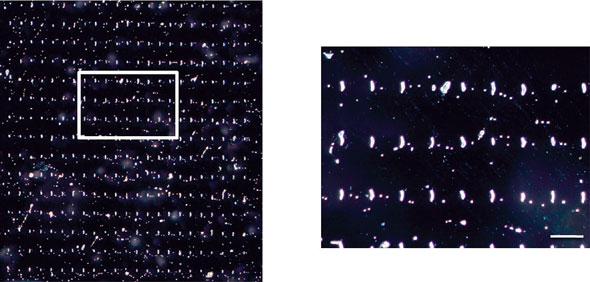| Posted: May 26, 2009 | |
Dead or alive - nanotechnology technique tells the difference |
|
| (Nanowerk Spotlight) A major concern in microbiology is to determine whether a bacterium is dead or alive. This crucial question has major consequences in food industry, water supply or health care. While culture-based tests can determine whether bacteria can proliferate and form colonies, these tests are time-consuming and work poorly with certain slow-growing or non-culturable bacteria. They are not suitable for applications where real-time results are needed, e.g. in industrial manufacturing or food processing. | |
| A team of scientists in France has now discovered that living and dead cells can be discriminated with a nanotechnology technique on the basis of their cell wall nanomechanical properties. This finding is totally new and has been made possible thanks to an interdisciplinary approach which mixes physics, biology and chemistry. This work is a key stone in the understanding of bacterial cell wall behavior. | |
| "We have developed a method to probe the mechanical properties of living and dead bacteria via atomic force microscope (AFM) indentation experimentations," Aline Cerf tells Nanowerk. ". Indeed, we provide a new way to probe bacterial cell viability based on cell wall nanomechanical properties, independently from cell ability to grow on a medium or to be penetrated by a fluorescent dye." | |
| Cerf, a PhD student in the NanoBioSystems group at LAAS-CNRS, is first author of a recent paper in Langmuir ("Nanomechanical Properties of Dead or Alive Single-Patterned Bacteria") where she and collaborators from LAAS-CNRS describe their findings. | |
| "We wanted to explore the modifications that could occur in the nanomechanical properties of a single E. coli bacterium, while it is alive and while it is dead," says Etienne Dague, a researcher in the NanoBioSystems group. "To reach this goal, it has been of first importance to immobilize the living bacteria in an aqueous environment to avoid any cell wall modifications due to a drying step." | |
| Thus, in developing a technique to probe the mechanical properties of bacteria via AFM indentation experiments, the French team also came up with an immobilization method for bacteria that doesn't require a chemical fixation. | |
 |
|
| Untreated bacteria deposition on a microstructured surface with APTES functionalized patterns (1100 µm x 1000 µm dark field image (left) with the corresponding zoomed image (right). Scale bar corresponds to 30 µm). (Reprinted with permission from American Chemical Society) | |
| The researchers set up a fast and simple procedure – based on a conventional microcontact printing and a simple incubation technique to generate functionalized patterns so as to induce local bacteria deposition – that allowed them to produce reliable chemical patterns exhibiting different surface properties to induce selective adsorption of individual bacteria in liquid media at registered positions. | |
| "We have evidenced a selective adsorption of bacteria on these local chemical patterns, producing highly ordered arrays of single living bacteria with a success rate close to 100%," says Cerf. | |
| The team then used this controlled immobilization method to study the mechanical properties of dead or alive bacterial cell in aqueous environment. Using force spectroscopy before and after heating , they measured the Young moduli of the same cell. The cells with a damaged membrane (after heating) present a Young modulus twice as high (6.1 ± 1.5 MPa versus 3.0 ± 0.6 MPa) as that of healthy bacteria. At the same time it has been impossible to evidence a difference between the AFM images of the living and the dead cell. | |
| "We have shown that we are capable of engineering large areas with patterns of single bacteria and this will be of major interest for future applications," says Dague. "Indeed, thanks to a periodic arrangement of cells, the process consisting in measuring the nanomechanical properties of cells could possibly be automated and a tool to count live or dead bacteria could be designed." | |
 By
Michael
Berger
– Michael is author of three books by the Royal Society of Chemistry:
Nano-Society: Pushing the Boundaries of Technology,
Nanotechnology: The Future is Tiny, and
Nanoengineering: The Skills and Tools Making Technology Invisible
Copyright ©
Nanowerk LLC
By
Michael
Berger
– Michael is author of three books by the Royal Society of Chemistry:
Nano-Society: Pushing the Boundaries of Technology,
Nanotechnology: The Future is Tiny, and
Nanoengineering: The Skills and Tools Making Technology Invisible
Copyright ©
Nanowerk LLC
|
|
Become a Spotlight guest author! Join our large and growing group of guest contributors. Have you just published a scientific paper or have other exciting developments to share with the nanotechnology community? Here is how to publish on nanowerk.com.
